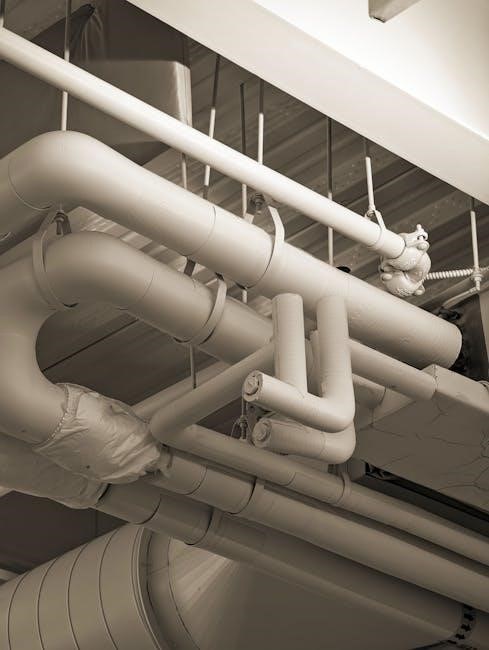flex duct installation guide

Flex duct installation is a popular method for HVAC systems due to its versatility and ease of installation. It offers excellent airflow and noise reduction.
1.1 Overview of Flex Ducts and Their Benefits

Flexible ducts, commonly known as flex ducts, are versatile HVAC components made of insulated, flexible plastic materials. They are widely used due to their ease of installation and ability to navigate tight spaces. Flex ducts are ideal for complex layouts, offering a cost-effective solution compared to rigid ducts. Their flexibility allows for smooth bends, reducing noise and vibrations in HVAC systems. Additionally, they provide excellent thermal insulation, minimizing heat loss and improving system efficiency. Flex ducts are also lightweight, making them easier to handle and transport. However, their performance heavily depends on proper installation, as sagging or kinking can reduce airflow and efficiency. Overall, flex ducts are a practical choice for modern HVAC systems, balancing affordability and functionality effectively.
1.2 Importance of Proper Installation for HVAC Efficiency
Proper installation of flex ducts is critical for ensuring optimal HVAC system performance. Improper techniques, such as sagging, kinking, or loose connections, can significantly reduce airflow and system efficiency. Flex ducts must be installed with the inner liner pulled tight to minimize friction and prevent energy losses. Sharp bends and excessive compression can restrict airflow, leading to higher energy bills and reduced comfort. Additionally, leaks or poorly sealed connections can allow conditioned air to escape, further diminishing efficiency. Following industry standards, such as those from the Air Diffusion Council, ensures that installations meet performance and safety requirements. Proper installation not only enhances system efficiency but also extends the lifespan of the ductwork, making it a crucial step in achieving a reliable and cost-effective HVAC system.
Planning and Preparation for Flex Duct Installation

Planning and preparation are crucial for successful flex duct installation. Selecting the right materials, assessing space, and designing the duct layout ensure efficiency and proper airflow.
2.1 Selecting the Right Materials and Tools

Selecting the right materials and tools is essential for a successful flex duct installation. Start by choosing high-quality flex ducts that meet industry standards, ensuring durability and optimal airflow. Insulation and protective coverings are also critical to maintain energy efficiency and prevent damage. Tools like duct cutters, utility knives, and wire brushes are necessary for precise cuts and smooth surfaces. Additionally, invest in proper fastening materials, such as metal clamps or zip ties, to secure connections tightly. A tensioning tool can be invaluable for tightening straps without over-compressing the duct. Refer to the Air Diffusion Council’s guidelines for recommended materials and tools to ensure compliance and performance. Properly equipping yourself with the right supplies will streamline the installation process and ensure a professional-grade result.
2.2 Assessing the Space and Designing the Duct Layout

Assessing the space and designing the duct layout is a critical step in flex duct installation. Begin by evaluating the installation area, considering factors like available space, obstacles, and accessibility. Measure the distance between vents, registers, and the HVAC unit to determine the most efficient duct routing. Use graph paper to sketch the layout, ensuring minimal bends and optimal airflow. Consider the flexibility of the ducts to navigate around structural elements. Properly designed ductwork minimizes sagging and kinking, which can reduce system efficiency. Refer to HVAC standards for guidance on spacing and routing. A well-planned layout ensures even air distribution, reduces noise, and maximizes system performance. Always consult professional guidelines to avoid common pitfalls and ensure a balanced airflow system. This step sets the foundation for a successful and efficient installation. Proper planning prevents costly rework and enhances overall comfort and energy efficiency.
2.3 Calculating Duct Sizes and Airflow Requirements
Calculating duct sizes and airflow requirements is essential for ensuring optimal HVAC performance. Use industry standards like ACCA Manual D to determine the correct duct dimensions based on the system’s airflow needs. Consider factors such as friction rates, static pressure, and the number of registers or vents. Proper sizing prevents energy losses and ensures even air distribution. Flexible ducts must be installed with minimal kinking or sagging to maintain airflow efficiency. Refer to the Air Diffusion Council’s guidelines for specific recommendations on duct sizing and installation practices. Accurate calculations ensure the system operates efficiently, reducing energy costs and improving comfort. Always verify measurements and airflow requirements before finalizing the duct layout to avoid performance issues. Proper sizing and airflow planning are critical for a successful flex duct installation and long-term system efficiency.

Installation Techniques for Flex Ducts
Proper techniques involve stretching ducts taut, using wide straps to prevent compression, and ensuring smooth, gradual bends to maintain airflow efficiency and system performance.
3.1 Step-by-Step Guide to Cutting and Fitting Flex Ducts
Cutting and fitting flex ducts requires precision to ensure proper airflow and system efficiency. Start by measuring the required length and marking the duct with a permanent marker. Use a utility knife or duct cutter to make clean, straight cuts, ensuring the inner liner remains intact. When fitting, stretch the duct to remove any slack and align it with the desired path. Secure the inner liner to connectors using metal clamps or screws, then seal with mastic or approved tape. Avoid over-compressing the duct, as this can restrict airflow. For bends, maintain a radius equal to or greater than the duct diameter to prevent kinking. Finally, inspect all connections for leaks and ensure the duct is properly supported to prevent sagging.

3.2 Securing Flex Ducts with Proper Straps and Supports
Securing flex ducts with proper straps and supports is crucial for maintaining airflow efficiency and preventing damage. Use durable straps made of materials like nylon or metal, ensuring they are at least 1.5 inches wide to avoid compressing the duct. Apply straps tightly but carefully to avoid restricting airflow. Supports, such as metal brackets or hooks, should be installed at intervals no greater than 4 feet apart, depending on the manufacturer’s guidelines. Ensure the duct sags no more than 1/2 inch per foot between supports to maintain structural integrity. Properly securing flex ducts prevents sagging, reduces friction, and ensures optimal HVAC performance. Always follow Air Diffusion Council standards for the best results.
3.3 Making Leak-Tight Connections and Seals

Making leak-tight connections and seals is essential for maintaining HVAC efficiency and preventing energy loss. Ensure the inner liner is securely connected to vents, elbows, and other components using metal clamps or sheet metal screws. Apply mastic or specialized tape to seal gaps, ensuring airtight joints. For added durability, wrap the connection with insulation and seal it again. Avoid using temporary materials like duct tape, as they degrade over time. Properly sealed connections reduce air leakage, improve airflow, and enhance system performance. Always follow Air Diffusion Council guidelines for secure and long-lasting seals. Inspect and test connections for leaks before finalizing the installation to ensure optimal results.

Common Mistakes and Troubleshooting in Flex Duct Installation
Common mistakes include sharp bends, sagging ducts, and improper connections, reducing airflow. Troubleshooting involves correcting these issues to ensure proper connections and optimal HVAC performance. Adhering to installation standards is crucial for efficiency and longevity.
4.1 Avoiding Installation Errors That Reduce Efficiency
Avoiding installation errors is crucial for maintaining HVAC efficiency. Common mistakes include sharp bends, which increase friction, and sagging ducts that restrict airflow. Properly tightening the inner liner is essential to prevent compression, as even 15% compression can double friction rates. Using metal elbows for bends greater than 20 degrees ensures smoother airflow and prevents kinking. Additionally, securing flex ducts with wide straps and proper spacing prevents sagging beyond the recommended 1/2 per foot. Ensuring leak-tight connections with mastic or approved clamps is vital, as leaks significantly reduce system performance. Following Air Diffusion Council standards and best practices helps minimize these errors, ensuring optimal airflow and system efficiency; Proper installation not only enhances performance but also extends the lifespan of the HVAC system.
4.2 Diagnosing and Repairing Leaks or Sagging Ducts
Diagnosing leaks in flex ducts often involves a thorough inspection for gaps or tears, especially at connections. Smoke tests or soapy water can help identify leaks. Repairing leaks typically involves sealing with mastic or high-quality duct tape. Sagging ducts can be identified by visible drooping between supports. To fix sagging, tighten the suspension straps or re-route the duct to eliminate sags. Ensure the inner liner is pulled taut during repairs to maintain airflow efficiency. If ducts are kinked or bent, straightening them without over-tightening is crucial. Properly resealing connections and reinforcing weak points prevents future issues. Addressing these problems promptly ensures optimal system performance and prevents energy losses due to inefficiencies.

Successful flex duct installation requires careful planning, precise execution, and adherence to industry standards. Proper techniques, such as tight inner liners and minimal sagging, ensure optimal airflow and efficiency. Regular inspections and maintenance are crucial to prevent leaks and damage. Troubleshooting common issues like sagging or leaks early can save time and energy. For a lasting system, follow best practices and invest in quality materials. Whether you’re a DIY enthusiast or a professional, staying informed and following guidelines ensures a reliable HVAC system. Always refer to resources like the Air Diffusion Council’s standards for guidance. With attention to detail and commitment to quality, your flex duct installation will deliver long-term comfort and efficiency;